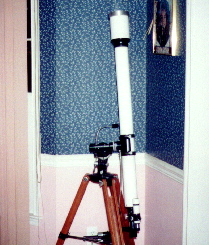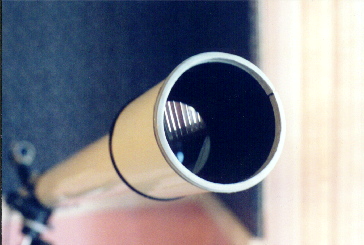|
|
|

6" f/8 Criterion EQ | 76mm f/16 Refractor | 8" f/6 Dobsonian |
Astrophotos | Observing | Resources & Links |
 Nothing beats the clean and crisp view from a refractor, especially a long-focus model. Stars are always tiny pinpoints of light and if the refractor is of any quality the excess color (chromatic abberation) will be to a minimum. My father and I stumbled on to such a beast about a year ago while at the local flea market.
Nothing beats the clean and crisp view from a refractor, especially a long-focus model. Stars are always tiny pinpoints of light and if the refractor is of any quality the excess color (chromatic abberation) will be to a minimum. My father and I stumbled on to such a beast about a year ago while at the local flea market.
Sitting in one of the vendors' closests for over 15 years was a 76mm f/16 ASTRO (Tokyo origin) refractor on a wooden tripod with heavy duty equitorial head. When I first saw the scope it looked to be identical to the older Unitrons of the 1950s (with only a few slight differences). In fact, the scope has been mistaken for Unitron manufacture a number of times while at star parties.
The views of Jupiter and Saturn are simply stunning; they will hold you and capture your imagination for incredible amounts of time. Festoons, white ovals, moon shadows, etc. are visible on Jupiter while the Cassini and Enckle (on occassion) divisions are visible on Saturn. On most nights the scope is easily capable of holding magnifications of 200x on the planets. For deep-space, with a 1.25" 32mm Plossl, the scope yields a field of view of 1 1/3 degree, large enough for most objects you will spot with it. While I haven't been able to coax M81 and M82 into the scope yet, I have bagged such objects as: M42, M78, M37, M36 and M45. The scope does not see as much use at night as it probably should, due to the following fact.
 A later addition to the scope was a Thousand Oaks Type II Solar filter. The filter was purchased used for a substantial savings over a new one and only minor adjustments to the dew-shield had to be made (notice the grey window stripping lining the shield in the picture). Views of the sun are also breath-taking, with sun spots visible almost every day. In fact, for the February 1997 partial eclipse (for those of us in the North East US) I brought the scope and filter with me to my astronomy club's gathering. Once there, members helped show the public the eclipse. The scope really has a story behind it and hopefully the story will continue to grow with the possibility of Hydrogen-Alpha viewing.
A later addition to the scope was a Thousand Oaks Type II Solar filter. The filter was purchased used for a substantial savings over a new one and only minor adjustments to the dew-shield had to be made (notice the grey window stripping lining the shield in the picture). Views of the sun are also breath-taking, with sun spots visible almost every day. In fact, for the February 1997 partial eclipse (for those of us in the North East US) I brought the scope and filter with me to my astronomy club's gathering. Once there, members helped show the public the eclipse. The scope really has a story behind it and hopefully the story will continue to grow with the possibility of Hydrogen-Alpha viewing.